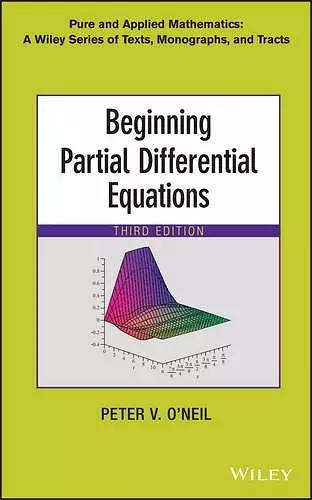Beginning Partial Differential Equations
Format:Hardback
Publisher:John Wiley & Sons Inc
Published:30th May '14
Currently unavailable, and unfortunately no date known when it will be back

A broad introduction to PDEs with an emphasis on specialized topics and applications occurring in a variety of fields
Featuring a thoroughly revised presentation of topics, Beginning Partial Differential Equations, Third Edition provides a challenging, yet accessible, combination of techniques, applications, and introductory theory on the subjectof partial differential equations. The new edition offers nonstandard coverageon material including Burger’s equation, the telegraph equation, damped wavemotion, and the use of characteristics to solve nonhomogeneous problems.
The Third Edition is organized around four themes: methods of solution for initial-boundary value problems; applications of partial differential equations; existence and properties of solutions; and the use of software to experiment with graphics and carry out computations. With a primary focus on wave and diffusion processes, Beginning Partial Differential Equations, Third Edition also includes:
- Proofs of theorems incorporated within the topical presentation, such as the existence of a solution for the Dirichlet problem
- The incorporation of Maple™ to perform computations and experiments
- Unusual applications, such as Poe’s pendulum
- Advanced topical coverage of special functions, such as Bessel, Legendre polynomials, and spherical harmonics
- Fourier and Laplace transform techniques to solve important problems
Beginning of Partial Differential Equations, Third Edition is an ideal textbook for upper-undergraduate and first-year graduate-level courses in analysis and applied mathematics, science, and engineering.
“I enjoyed perusing O’Neil’s book. A beginner in the field of PDEs will learn quite a number of juicy facts concerning the flow of heat and the transmission of waves. While a next step will undoubtedly involve more rigor in the use of analytic tools, this first course will catch the attention of those with a curiosity for studying physical processes using differential equations.” (Mathematical Association of America, 15 February 2015)
“This book is one of the textbooks that provide an introduction to basic methods and applications of partial differential equations for students of mathematics, physics and engineering.” (Zentralblatt MATH, 1 October 2014)
ISBN: 9781118629949
Dimensions: 241mm x 163mm x 29mm
Weight: 744g
456 pages
3rd edition